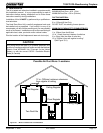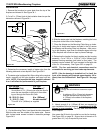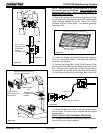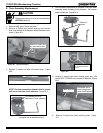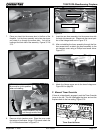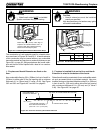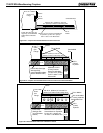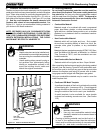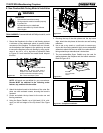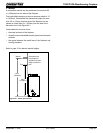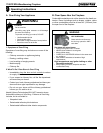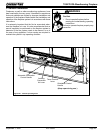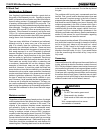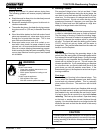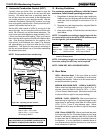
September 1, 2008
433-1390G
Page 41
7100FP EPA Woodburning Fireplace
R
Seal with
non-combustible
sealant
C. Position the Hearth Extension
Position and secure the hearth extension over the protective
metal strips that have been placed partially under the fireplace
front. These strips should be protruding approximately 2 in.
(51 mm) from under the fireplace front and 2 in. (51 mm) on
both sides of the fireplace opening. See Figure 19.1 on page
19. Seal the crack between the hearth extension and
fireplace with a bead of non-combustible sealant. See
Figure 41.1. Apply a non-combustible finishing material of
your choice to the hearth extension.
NOTE:
SEE PAGES 10-12 & 38 “CLEARANCES TO COM-
BUSTIBLES, HEARTH EXTENSIONS / FLOOR PROTEC-
TION” FOR CLEARANCES REQUIRED FOR DIFFERENT
HEARTH EXTENSION INSTALLATIONS. THE CLEAR-
ANCES MUST BE STRICTLY ADHERED TO.
Figure 41.1 Position the Hearth Extension
Fire Risk
• Hearth extensions are to be installed only
as illustrated to prevent high temperatures
from occurring on concealed combustible
materials.
• Hearth sealing strips prevent burning or
hot particles from inadvertently falling
directly on combustible surfaces in the
event the building should settle and
disturb the original construction.
WARNING
Fire Risk
• Maintain clearances.
• Use only non-combustible material below
standoffs, material such as cement board is
acceptable.
WARNING
• Framing or finishing material used on the front of, or
in front of, the appliance closer than the minimums
listed, must be constructed entirely of noncombustible
materials (i.e., steel studs, concrete board, etc.).
• Combustible Material
Materials made of or surfaced with wood, compressed
paper, plant fibers, plastics, or other materials that can
ignite and burn, whether flame proofed or not, or whether
plastered or un-plastered shall be considered combus-
tible materials.
• Non-Combustible Material
Materials which will not ignite and burn. Such materi-
als are those consisting entirely of steel, iron, brick, tile,
concrete, slate, glass or plasters, or any combination
thereof.
Materials that are reported as passing ASTM E 136, Stan-
dard Test Method for Behavior of Materials, in a Vertical
Tube Furnace at 750°C, shall be considered non-com-
bustible materials.
• Non-Combustible Sealant Material
Sealants which will not ignite and burn: Super Calstick
After completing the framing and applying the facing material
(drywall) over the framing, a bead of non-combustible seal-
ant must be used to close off any gaps at the top and sides
between the fireplace and facing to prevent cold air leaks.
Large gaps can be bridged with fiberglass rope gasket.
Only non-combustible materials may be used to cover the
metal fireplace front.
• Cardboard OR Metal Template
A cardboard template of the front is printed on the outside
of the shipping box. It measures 1/8 in. (3 mm) bigger all
the way around than the actual front. Cut out the template
along the outside of the line for use in your installation.
A metal template is also available for more durable
continued use remaining accurate over time. (See Section
12.E).
D. Finishing Material
Do not install combustible materials over the metal fire-
place face of the fireplace! This poses a safety hazard and
may start a fire. You may only use noncombustible material
over the metal face of the fireplace. NOTE: The decorative
fascia must be removable for future serviceability of the
Automatic Combustion Control.



